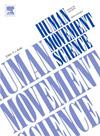The effect of run duration, gait variable and Lyapunov exponent algorithm on the inter-session reliability of local dynamic stability in healthy young people
IF 1.9
3区 心理学
Q4 NEUROSCIENCES
引用次数: 0
Abstract
Local dynamic stability (LDS) of gait has been used to differentiate between healthy and injured populations, establishing its potential as an indicator of healthy gait and a new objective measure to assess gait function following injury. For LDS to be a reliable assessment tool of healthy gait progression during rehabilitation, it must provide consistent and sensitive inter-session measures. Methodological factors such as trial duration, gait variable, and Lyapunov Exponent (LyE) algorithm can influence LDS estimation and its reliability. Young people are a high-risk population for sport-related injuries, and running is a key activity during rehabilitation and is regularly assessed. Therefore, the effects of run duration, gait variable, and LyE algorithm choice on the reliability and sensitivity of inter-session LDS measures in young people were investigated. Sixteen healthy participants ran on a treadmill on two separate sessions (difference of 7 ± 5 days). LDS was calculated using both the Rosenstein and Wolf algorithm for durations of 1-, 2-, 3-, 4- and 5-min of knee flexion angle and medio-lateral acceleration of the pelvis and thorax from each session. The relative and absolute reliability between sessions was calculated using the intraclass correlation coefficient and standard error of measurement. The sensitivity of inter-session LDS change was quantified by the minimal detectable change. Results showed that longer run durations produced higher relative reliability and a minimum run duration of 4 min is recommended to achieve moderate-to-good inter-session reliability across all gait variables and LyE algorithms. However, shorter durations of 2–3 min may still be sufficient when using medio-lateral pelvis acceleration or knee flexion angle, particularly with the Rosenstein algorithm, which also improves sensitivity to change. These findings provide practical guidance for methodological choices when calculating LDS in young people during running and support their potential use as reliable tools for monitoring gait function and tracking rehabilitation progress in young people following injury.
跑步持续时间、步态变量和Lyapunov指数算法对健康青少年局部动态稳定性会话间可靠性的影响。
步态局部动态稳定性(LDS)已被用于区分健康人群和受伤人群,确立了其作为健康步态指标和评估损伤后步态功能的新客观指标的潜力。为了使LDS成为康复期间健康步态进展的可靠评估工具,它必须提供一致和敏感的间歇测量。试验时间、步态变量和Lyapunov指数(LyE)算法等方法学因素会影响LDS估计及其可靠性。年轻人是运动相关损伤的高危人群,跑步是康复过程中的一项关键活动,并定期进行评估。因此,我们研究了跑步时间、步态变量和LyE算法选择对年轻人间歇LDS测量的可靠性和灵敏度的影响。16名健康的参与者在跑步机上进行两个独立的训练(相差7±5天)。LDS的计算采用Rosenstein和Wolf算法,分别计算每次1分钟、2分钟、3分钟、4分钟和5分钟的膝关节屈曲角度以及骨盆和胸腔的中外侧加速度。采用组内相关系数和测量标准误差计算组间的相对信度和绝对信度。通过最小可检测变化来量化间歇LDS变化的敏感性。结果表明,较长的跑步持续时间产生较高的相对可靠性,建议在所有步态变量和LyE算法中,最小跑步持续时间为4分钟,以实现中等至良好的间歇可靠性。然而,当使用骨盆中外侧加速或膝关节屈曲角度时,2-3分钟的较短持续时间可能仍然足够,特别是使用Rosenstein算法,该算法也提高了对变化的敏感性。这些发现为计算年轻人跑步时LDS的方法选择提供了实用的指导,并支持它们作为监测年轻人受伤后步态功能和跟踪康复进展的可靠工具的潜在用途。
本文章由计算机程序翻译,如有差异,请以英文原文为准。
求助全文
约1分钟内获得全文
求助全文
来源期刊

Human Movement Science
医学-神经科学
CiteScore
3.80
自引率
4.80%
发文量
89
审稿时长
42 days
期刊介绍:
Human Movement Science provides a medium for publishing disciplinary and multidisciplinary studies on human movement. It brings together psychological, biomechanical and neurophysiological research on the control, organization and learning of human movement, including the perceptual support of movement. The overarching goal of the journal is to publish articles that help advance theoretical understanding of the control and organization of human movement, as well as changes therein as a function of development, learning and rehabilitation. The nature of the research reported may vary from fundamental theoretical or empirical studies to more applied studies in the fields of, for example, sport, dance and rehabilitation with the proviso that all studies have a distinct theoretical bearing. Also, reviews and meta-studies advancing the understanding of human movement are welcome.
These aims and scope imply that purely descriptive studies are not acceptable, while methodological articles are only acceptable if the methodology in question opens up new vistas in understanding the control and organization of human movement. The same holds for articles on exercise physiology, which in general are not supported, unless they speak to the control and organization of human movement. In general, it is required that the theoretical message of articles published in Human Movement Science is, to a certain extent, innovative and not dismissible as just "more of the same."
 求助内容:
求助内容: 应助结果提醒方式:
应助结果提醒方式:


